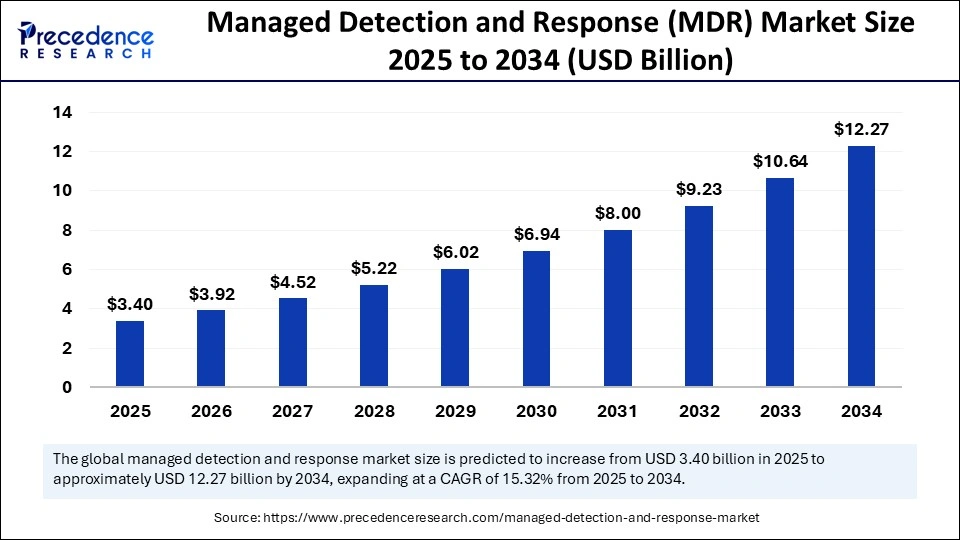
Managed Detection and Response (MDR) Market Key Takeaways
- North America dominated the global market with a largest market share of 46% in 2024.
- Asia Pacific is expected to witness the fastest growth in the coming years.
- By security type, the cloud detection and response segment led the market in 2024.
- By security type, the managed endpoint detection and response (MEDR) segment is expected to expand at the fastest growth during the forecast period.
- By deployment, the cloud-based segment contribute the biggest market share in 2024.
- By deployment, the on-premises segment is likely to grow rapidly during the projection period.
- By enterprise size, the SMEs segment held the largest share in 2024.
- By enterprise size, the large enterprises segment is expected to expand at the highest CAGR between 2025 and 2034.
- By vertical, the BFSI segment led the market with the largest share in 2024.
- By vertical, the IT & telecom segment is likely to witness the fastest growth in the upcoming period.
Market Overview
The managed detection and response (MDR) market is witnessing robust growth as cyber threats evolve in sophistication and volume. MDR services combine advanced analytics, endpoint detection, threat intelligence, and 24/7 monitoring to help organizations detect and respond to cyber incidents swiftly. As cybersecurity becomes a board-level priority, businesses are turning to MDR providers to augment their existing security infrastructure and achieve greater resilience. The demand for MDR is rising across both highly regulated industries and digital-first enterprises seeking to reduce mean time to detect (MTTD) and respond (MTTR).
Drivers
Key drivers propelling the MDR market include the rising prevalence of advanced persistent threats (APTs), phishing attacks, and insider risks. Regulatory frameworks are becoming more stringent, requiring faster detection and reporting of breaches. Organizations are also recognizing the need for proactive threat hunting, which MDR services provide as a core feature. The convergence of IT and OT networks in sectors like manufacturing and energy has introduced new attack vectors, increasing the necessity for real-time threat visibility across environments.
Opportunities
The integration of AI and behavioral analytics into MDR platforms offers a powerful opportunity for vendors to enhance threat detection accuracy and reduce false positives. As enterprises migrate to hybrid and multi-cloud architectures, MDR services that support cloud-native security monitoring are in high demand. Another area of growth is the expansion of MDR services into emerging markets, where digital transformation is accelerating but cybersecurity maturity is still developing. Tailoring MDR offerings for managed service providers (MSPs) and channel partners can also expand reach and improve service delivery in underserved segments.
Challenges
Challenges in the MDR market include the need to maintain data sovereignty and compliance with local data residency laws, especially when handling sensitive client information. Vendor lock-in and lack of transparency around detection logic and response protocols are concerns for many organizations. Additionally, the evolving threat landscape demands constant innovation, putting pressure on MDR providers to continuously update and adapt their offerings. Building customer trust and demonstrating measurable outcomes in security posture improvement remain critical hurdles for market penetration.
Regional Insights
The United States leads in MDR adoption due to a combination of high cybersecurity awareness, regulatory enforcement, and a concentration of critical infrastructure. Europe is following closely, spurred by initiatives such as the Network and Information Security Directive (NIS2) and GDPR. Asia-Pacific is a fast-growing region, with large enterprises and governments investing in cybersecurity to support digital growth. Middle Eastern nations are embracing MDR services as part of national cybersecurity strategies, while African countries are gradually adopting these solutions in financial and telecom sectors.
Recent Developments
Recent innovations include the launch of AI-powered threat detection engines capable of autonomous investigation and contextual analysis. Vendors are embedding MDR capabilities into XDR (Extended Detection and Response) platforms to provide a unified security operations experience. Some providers have introduced region-specific service models to address data sovereignty concerns and compliance requirements. M&A activity is rising, with large cybersecurity firms acquiring MDR startups to expand their portfolio and reach.
Managed Detection and Response (MDR) Market Companies
- Accenture
- Arctic Wolf Networks Inc.
- CrowdStrike
- Deepwatch
- FORESCOUT
- Fortra, LLC
- LMNTRIX
- Rapid7
- Red Canary
- Secureworks
Segments Covered in the Report
By Security Type
- Managed Endpoint Detection And Response (MEDR)
- Managed Network Detection And Response (MNDR)
- Cloud Detection And Response
- Others
By Deployment
- Cloud-based
- On-premises
By Enterprise Size
- SMEs
- Large Enterprises
By Vertical
- BFSI
- Retail
- IT & Telecom
- Healthcare
- Manufacturing
- Government & Defense
- Others
By Region
- North America
- Europe
- Asia Pacific
- Middle East & Africa
- Latin America
